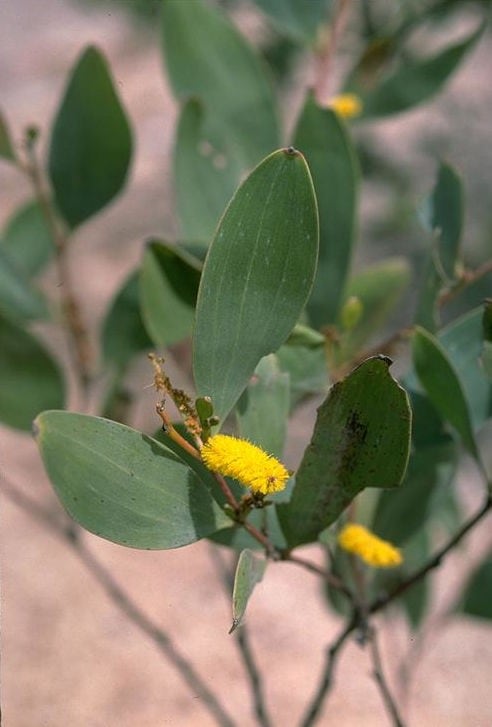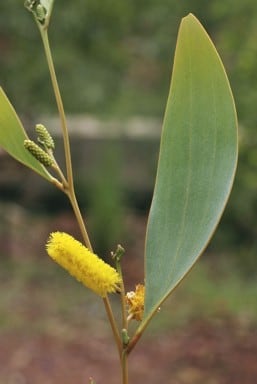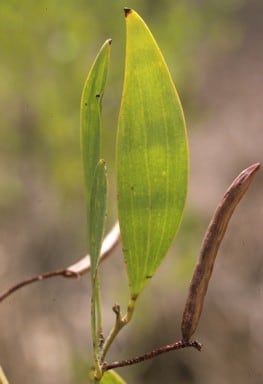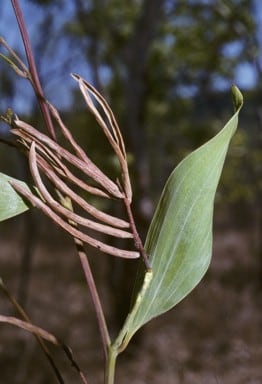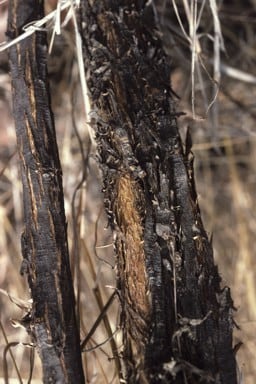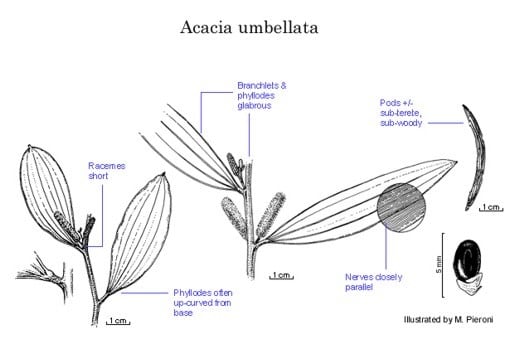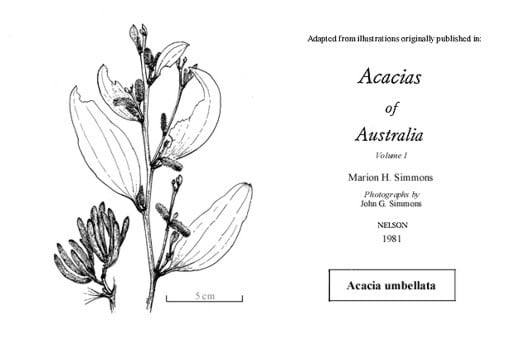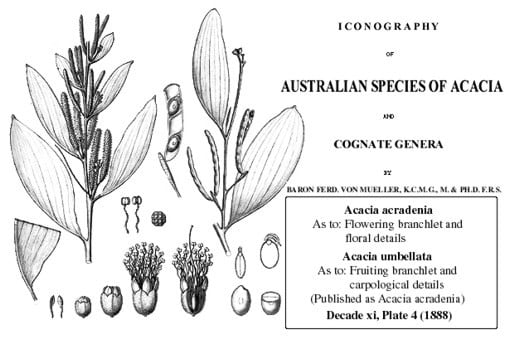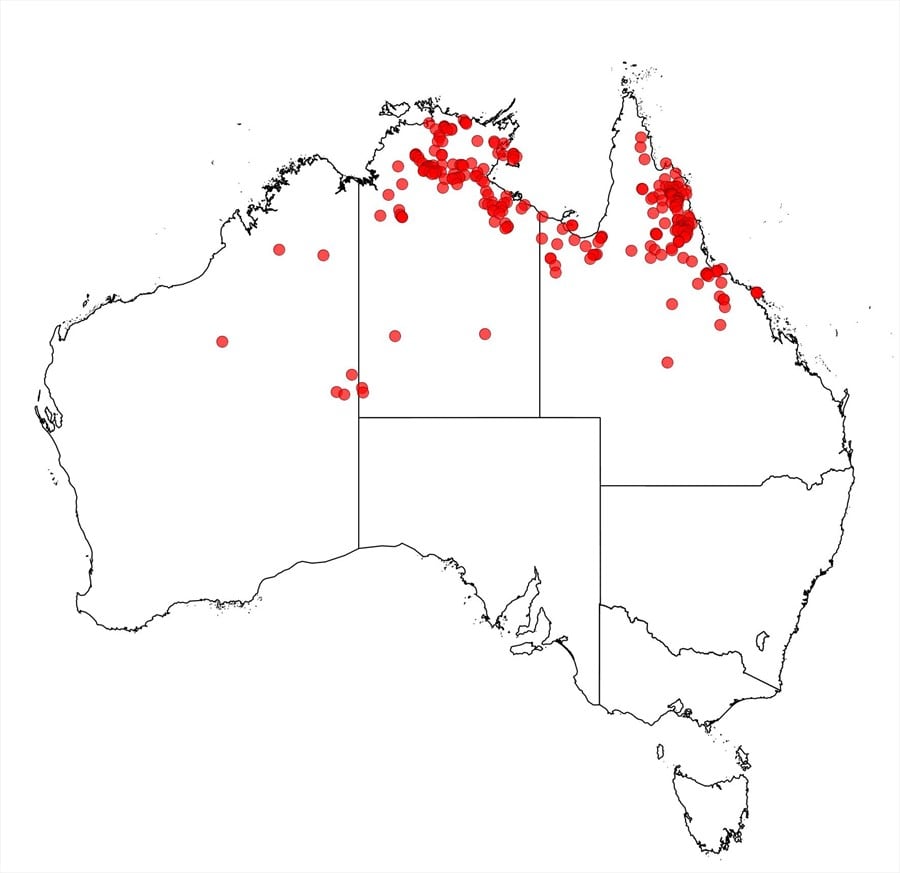Acacia umbellata A.Cunn. ex Benth.
WATTLE
Acacias of Australia
Family
Fabaceae
Distribution
Widespread in northern N.T. to 19ºS and on the Gulf of Carpentaria islands, and in coastal and subcoastal Qld, mainly S of Cooktown in the Cook, Burke and N of Kennedy Districts.
Description
Shrub to 3 m high, multistemmed, ±semiprostrate, or rarely tree 3–6 m (N.T.), resinous. Bark stringy, brown or blackish grey. Branchlets terete, grey-brown to dark red-brown, ±glabrous or scurfy. Young shoots compressed or angular. Phyllodes erect or upcurved, oblique, narrowly lanceolate to lanceolate or narrowly elliptic to broadly elliptic, 5–14.5 cm long, 10–43 mm wide, obtuse, glabrous, with 1–3 prominent and 3 or 4 subprominent nerves often confluent with lower margin near base; minor nerves 8–12 per mm, longitudinal, non-anastomosing; marginal nerve slightly thickened, similar to main nerves; gland 1, small, basal. Spikes 0.7–2 (–3.4) cm long, golden. Flowers 5 (or 6)-merous; calyx 0.7–1.3 mm long, sinuate or dissected to 1/3–1/4, pubescent to subglabrous, with margins fimbriolate; corolla 1.2–2 mm long, dissected to ±1/2, glabrous; ovary papillose. Pods in erect clusters, linear, ±straight-sided, subterete, mostly 1.7–6.2 cm long, 2.5–5 mm wide, thinly crustaceous, longitudinally furrowed. Seeds longitudinal, elliptic-oblong, 3.5–5 mm long, black.
Phenology
Flowers Apr.–July or throughout the year.
Habitat
Grows in dry stony or sandy soil, on creek banks, often in eucalypt woodland on rocky slopes and ridges, on sandstone, quartzite, granite, schist or siltstones.
Specimens
N.T.: Maria Is., C.Dunlop 2909 (DNA, NSW); Beswick Ck, on Maranboy–Beswick road, M.D.Tindale 6071 & C.Dunlop (CANB, K, NSW, TL, UNSW, US, Z). Qld: Shute Harbour, R.G.Coveny 6923 & P.Hind (A, AD, BRI, CANB, K, MEL, NSW, UC, US); 2.4 km E of Battle Camp Stn on old Laura–Cooktown road, K.Hill 1923 et al. (BRI, NSW); 64 km W of Cooktown, R.Story 7978 (BRI, CANB, K, NSW).
Notes
There is considerable variation in the shape of the phyllodes. It is allied to A. acradenia which differs in being a spindly shrub with few branches, densely pubescent branchlets, minutely appressed-hairy phyllodes, 2–6.5 cm long spikes and compressed-terete pods to 13 cm long.
FOA Reference
Data derived from Flora of Australia Volumes 11A (2001), 11B (2001) and 12 (1998), products of ABRS, ©Commonwealth of Australia
Author
Dr M.D.Tindale and Dr P.G.Kodela with the assistance of M.Bedward, S.J.Davies, C.Herscovitch, D.A.Keith and/or D.A.Morrison
Minor edits by B.R.Maslin & J.Rogers
This identification key and fact sheets are available as a mobile application:
URL: https://apps.lucidcentral.org/wattle/
© Copyright 2018. All rights reserved.
